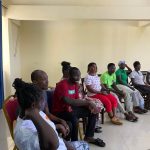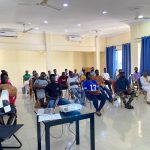It has emerged that an estimated 6,215 mothers with HIV and AIDS in need of antiretroviral (ART) drugs are not on the treatment.
According to available data, out of an estimated 18,263 mothers who need Prevention of Mother-to-Child-Transmission (PMTCT), only 12,048 mothers are receiving it.
These were contained in the 2017 HIV Sentinel Survey (HSS) and Estimates Report, jointly released by the National Acquired Immune Deficiency Syndrome (AIDS) and Sexually Transmitted Infections (STI) Control Programme (NACP).
3,422 Mother-to-Child Transmission cases
The report revealed that child infections due to Mother-to-Child Transmission (MTCT) were 3,422.
Also, last year, new HIV infections of children of ages one day to four years were 574.
8,440 Children of 1-4 years have HIV
A total of 8,440 children of ages ranging from one day to four years have HIV.
Explaining why the mothers needing the ART are not on treatment, Dr Stephen Ayisi Addo, Head of National AIDS Control Programme (NACP), attributed the situation to various challenges.
According to him, while there are over 2,500 centres for testing in the elimination programme, there are only 375 centres for treatment.
However, he said, not all the ART centres supply ART to persons living with HIV/AIDS.
This is because, until last year, only qualified doctors administered ART.
As a result, Dr Ayisi Addo disclosed that NACP is training midwives and nurses, and developing guidelines on how to administer ART as part of plans to decentralise the system.
He told The Finder that some of the pregnant women who are referred to ART centres do not go because of challenges such as inability to secure transport fare.
He added that some of these estimated pregnant women are not on treatment because not all women attend antenatal clinics, but rather deliver at home.
The head of NACP charged all health workers to ensure that all pregnant women who visit their facilities get tested, and those who test positive are put on ART.
1.67% prevalence rate in 2017
In 2017, the estimated Adult National HIV Prevalence was 1.67%.
313,063 Persons living with HIV and AIDS
An estimated 313,063 people, comprising 284,860 adults and 28,203 children, are persons living with HIV and AIDS.
19,101 New infections in 2017
According to the report, there is an estimated 19,101 new infections, made up of 15,679 adults and 3,422 children.
15,694 Annual AIDS Deaths
The report recorded an estimated 15,694 Annual AIDS Deaths. This is made up of 12,792 adults and 2,902 children. The report identified that HIV infection among STI clients is high and rising, thus screening of patients who report to all health facilities in Ghana with STIs for HIV may provide an opportunity for early detection of the disease.
The strong link between STI and HIV transmission is thus reaffirmed, hence the need for sustained HIV interventions in STI clinics.
HIV sub-type 1
HIV sub-type 1 is still the most dominant, with a proportion of 99%.
HIV sub-type II
Prior to 2017, there was no HIV sub-type II; however, 2017 recorded 0.2%.
The re-emergence of HIV sub-type II only infection may portend a re-infection dynamic.
Source: The Finder














